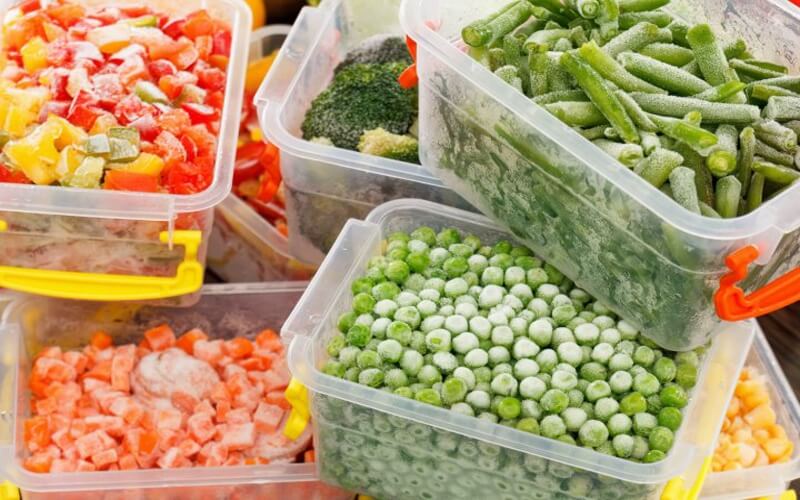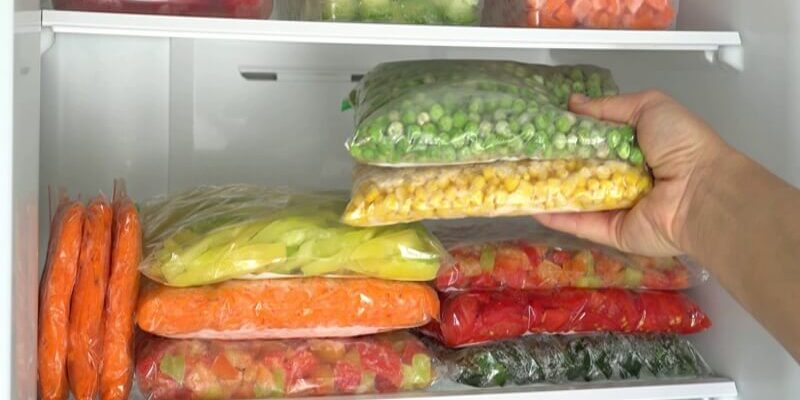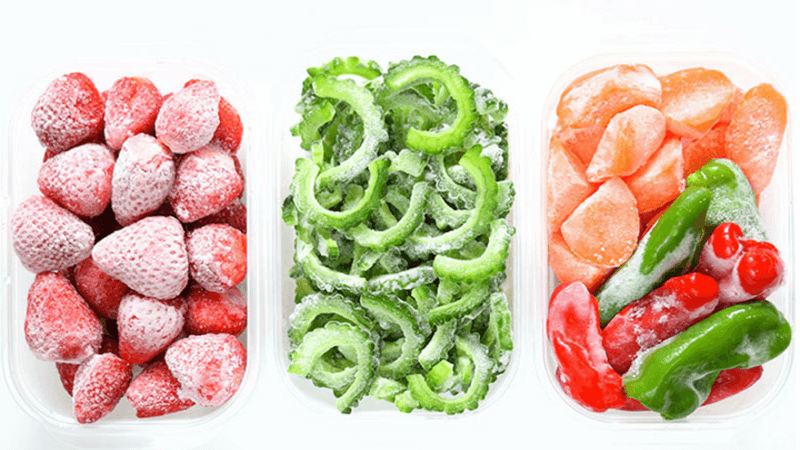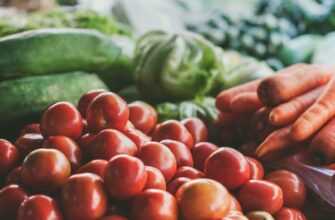At the time of purchase, vegetables still shone in their crispest colors, but after a few weeks in the freezer, their shine and freshness have faded. Some other foods have become stained in their cold sleep or taste bland or sour after thawing. If only you had reacted in time – but keeping track of all the cans and bags in the freezer is hard. Find out here how to store food in the freezer, keep an overview of everything and even save energy.
- How to keep frozen food as fresh as possible.
- Tip 1: Buy fresh
- Tip 2: Avoid air in the packaging
- Tip 3: Freeze in portions
- Tip 4: Prepare the food to be frozen
- Tip 5: Let the food freeze through quickly.
- How to keep your freezer tidy
- Tip 6: Stack the frozen food optimally
- Tip 7: Label the frozen food
- Saving energy when freezing
- Tip 8: Set up the freezer correctly
- Tip 9: Defrost the freezer regularly
- Tip 10: Choose a freezer that is as small as possible
- How to defrost food properly again
- Tip 11: Use some foods immediately
- Tip 12: Meat and fish: Slow is better
- Freeze better – enjoy fresher
- What lasts how long?
How to keep frozen food as fresh as possible.
The cold sleep in the freezer slows down the process that causes food to spoil. But how successfully this brake works and how fresh the food still tastes after thawing depends on various factors. With the following measures, you can create suitable conditions.
Tip 1: Buy fresh
Buy food as fresh as possible and freeze it as soon as possible, preferably immediately after purchase. Because the loss of quality before freezing cannot be compensated.
Tip 2: Avoid air in the packaging
Whether in the freezer bag or in the plastic box: Leave as little air as possible in the packaging, otherwise there is a risk of freezer burn. Avoid this by filling a can generously or wrapping a bag more tightly around the frozen food. Also, neither air nor moisture should be able to penetrate the packaging from the outside. Meat and fish are best vacuum-packed by the retailer.
But be careful: do not fill a package completely to below the rim. Food containing water can expand, causing bags to burst open or the lids of plastic cans to open.
Tip 3: Freeze in portions
Food that has been thawed once should not be frozen a second time if it has been exposed to room temperature for a long time. Therefore, pre-portion the frozen food so that you only ever defrost the amount that you actually use. Another advantage is that smaller portions freeze faster.
You can pre-portion liquids in ice cube molds. This is suitable for everything you need smaller quantities of when cooking, for example coconut milk or broth.
Tip 4: Prepare the food to be frozen
Any food can be prepared for cold storage before freezing to best preserve freshness.
- Vegetables should always be blanched.
- Unless it was vacuum-packed at the time of purchase, remove meat from packaging as soon as possible and pat dry before freezing.
- Small pieces of fruit should be placed side by side on a plate in the freezer for about two hours and then placed in the final packaging to prevent them from sticking together.
- Freshly prepared sauces or leftovers should be placed in the packaging so that the heat of the food consumes oxygen and creates a vacuum effect. After cooling, it then goes into the freezer.
Tip 5: Let the food freeze through quickly.
The faster the food freezes completely through, the less loss of quality there will be. For frozen food weighing more than one kilo, use the “shock freeze” function of your freezer if possible. It also makes sense to place new frozen food as freely as possible in the freezer first, instead of placing it on top of other items. This way it freezes more evenly.

How to keep your freezer tidy
The freezer is almost overflowing and you have lost track of what you have frozen and when, and where it is? The following measures will help you.
Tip 6: Stack the frozen food optimally
The more box-shaped the packaging, the easier it is to stack the frozen food on top of each other – in drawer compartments also next to each other. The following trick helps so that you don’t need too many cans for this and can freeze according to portion size:
- Put the frozen food in a freezer bag and place it in a rectangular box, such as a freezer can or a square bowl.
- Ideally, the freezer bag has a straight zip closure on the top or is welded shut. If it is knotted, place the knot as far to the side as possible.
- Place the box in the freezer for about two hours.
- Remove the bag from the box and check to see if it retains its rectangular shape. If it does, put the bag solo in the freezer, otherwise let everything pre-freeze a little longer.
- If you always use the same rectangular box, you will always have flat-bottomed freezer bags of the same length and width, which will stack perfectly.
Tip 7: Label the frozen food
If you freeze a lot of different foods, careful labeling will help you keep track of them.
- It’s best to use stickers or remember to use wipeable pens on cans. Some freezer bags have white squares that you can label directly without the writing being hard to read against the frozen food in the background.
- Write with a thick pen whose writing you can read at first glance in the freezer without having to remove the frozen food.
- Write on the sticker: the contents, the freezing date, the approximate expiration date (see box).
- Place the sticker on the side facing you when you look into the freezer.
Saving energy when freezing
With the right measures, freezing is not only a particularly effective, but also inexpensive method of preserving food.
Tip 8: Set up the freezer correctly
Place the freezer in a location that is as cool as possible. After all, the cooler the ambient air, the less energy your freezer will need to maintain the freezing temperature.
Tip 9: Defrost the freezer regularly
Defrost the freezer regularly before a layer of ice forms on the walls. Up to one-third more energy is required by an appliance with only a few millimeters of ice buildup.
Tip 10: Choose a freezer that is as small as possible
Use the interior of your freezer as fully as possible. The greater the freezing effect and the less energy you use to cool a room you don’t even need. If you want to buy a new freezer, think about the maximum amount you will freeze in order to choose the smallest possible size for the freezer.
How to defrost food properly again
Even after cold storage, you can still harm the quality of food by doing it wrong when defrosting. The following tips will keep you on the safe side.
Tip 11: Use some foods immediately
Some foods don’t need to be defrosted at all. This doesn’t just apply to frozen pizza, which can go straight into the oven. You can also use vegetables immediately after reaching into the freezer, so fewer ingredients are lost. Put the vegetables – or the still-closed freezer bag – in a pot of hot water and cook for a short time. You can also process frozen fruit directly, for example for desserts or on the pastry case for cakes.
Tip 12: Meat and fish: Slow is better
Meat and fish should be defrosted as slowly and gently as possible. Keep the following in mind:
- Ideally, thaw fish and meat the day before you want to use them.
- Put both in the refrigerator to defrost. Room temperature and especially heating are taboo, as germs and bacteria multiply more quickly in the heat. Meat should not be removed from the refrigerator until about an hour before roasting.
- Leave meat and fish in their packaging when defrosting or ensure that the defrost water can drain off, for example by placing the food in a container with a sieve.
- Do not use the defrost water! This applies in particular to the defrost water of poultry, as salmonella may be present in it.
- To speed up the defrosting process, place the still frozen package in a cold water bath. Do not use hot water to avoid triggering the cooking process.
- Food that you have stored at room temperature for a long time after defrosting should not be refrozen for safety reasons. This is especially true for red meat.
Freeze better – enjoy fresher
Freezing has enormous advantages for consumers. With winter vegetables in summer or fresh herbs in the cold season, there are virtually no more seasons in culinary terms. In addition, it saves a lot of work to pre-cook large quantities and always have ready meals in the house if there is not enough time for fresh preparation. And on top of that, the vitamins and other valuable ingredients of vegetables or fruits, for example, are not only preserved longer, but also better. If you then also freeze and defrost everything appropriately and keep track of everything in the freezer with just a few tricks, you can enjoy all these advantages to the full – in the truest sense of the word.
What lasts how long?
There is no general minimum shelf life for frozen foods. For meat: the fatter, the shorter; for cheese: the harder and drier, the longer. For the most common foods, the following guideline times apply:
- Beef: 10-12 months
- Pork: 4-8 months
- Poultry: 8-10 months
- Veal: 9-12 months
- Minced meat: 1-3 months
- Fish: 4 months
- Vegetables: 3-12 months
- Fruit: 9-12 months
- Cheese: 2-6 months
- White bread: 1-3 months
- Wholemeal bread: 4-6 months










